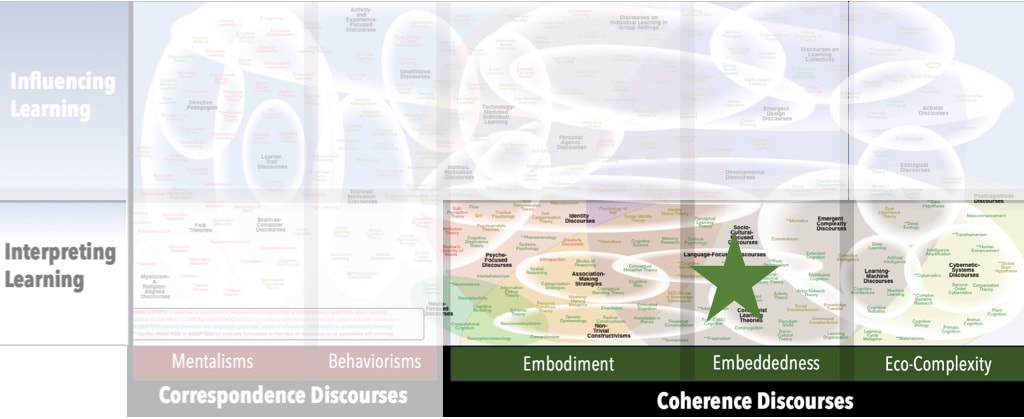Focus
Distinguishing among and ranking stages of complexity of a system’s dynamicsPrincipal Metaphors
- Knowledge is … range of developmental possibility
- Knowing is … stage-specific dynamics
- Learner is … any dynamic system
- Learning is … consolidating (current stage) and progressing (to next stage)
- Teaching is … matching (cognitive demand to stage); supporting (development of next level)
Originated
1980sSynopsis
Included among Developmental Discourses, the Model of Hierarchical Complexity is a stage/order-based perspective on learning and functioning that is designed to be applicable across species and cultures, to both individuals and collectives, and to both mechanical and organic entities. Based on increasingly complex demands of tasks (vs. cognitive or social development), each of the 17 orders is defined in terms of logical-scientific processes that are necessary to subsequent levels: 0. Calculatory Order of Complexity – human-designed computational programs used to manipulate (but not generalize from) data 1. Automatic Order of Complexity – unlearned, cause-and-effect (“hard-wired”) reaction to an environmental stimulus 2. Sensory or Motor Order of Complexity – conditioned response, involving discrimination of a stimulus/trigger and a learned reaction 3. Circular Sensory-Motor Order of Complexity – repetitive actions associated with a specific intention (e.g., babbling sounds, shaking objects) 4. Sensory-Motor Order of Complexity – deliberate, selective responses based on a category, a generalization, or another type of concept 5. Nominal Order of Complexity – notices relationships among concepts, demonstrated by use nouns, verbs, voice tone, etc. 6. Sentential Order of Complexity – develops stable sequences of acts by imitating others, chaining words, etc. 7. Preoperational Order of Complexity – makes conjectures and draws simple conclusions; recounts stories; uses propositional terms (e.g., if, why, as, when) 8. Primary Order of Complexity – makes simple logical deductions; does simple arithmetic; applies empirical rules to gather evidence; demonstrates awareness of time 9. Concrete Order of Complexity – follows complicated arithmetic procedures; uses and manages social rules; coordinates perspectives with those of others 10. Abstract Order of Complexity – identifies and reasons using qualifiers (e.g., situational variables, such as time, location, agents, conditions) and quantifiers (e.g., all, most, some, none) 11. Formal Order of Complexity – uses sound logic or robust evidence to deal effectively with one-dimensional and/or linear-causal phenomena 12. Systematic Order of Complexity – considers multiple variables across systems of relationships (e.g., legal, political, social, and mathematically modeled systems) 13. Metasystematic Order of Complexity – forms metasystems from multiple systems of relationships; identifies and compares systems and system properties 14. Paradigmatic Order of Complexity – distills paradigms by reading across metasystems 15. Cross-Paradigmatic Order of Complexity – creates hybrid domains by blending paradigms (e.g., Neuroscience + education = Neuroeducation) 16. Meta-Cross-Paradigmatic Order of Complexity – recursively engages in cross-paradigmatic thinking, attending to inherent limitations and emergent possibilities of such thinkingCommentary
The Model of Hierarchical Complexity has not reached a broad audience in education, and so there are few relevant commentaries. An obvious concern would be that it is of limited utility in a pragmatic domain. A more subtle criticism would be the apparent disconnect between the explicit formal-mathematical foundation of the theory and the claim that it is culturally (and species) unbiased.Authors and/or Prominent Influences
Michael Collins; Francis RichardsStatus as a Theory of Learning
The Model of Hierarchical Complexity is a theory of learning – or, more precisely perhaps, a theory of learning systems.Status as a Theory of Teaching
The Model of Hierarchical Complexity is not a theory of teaching, but it has obvious implications for teaching at each stage.Status as a Scientific Theory
Authors of the Model of Hierarchical Complexity have gone to extensive efforts to index their model of other Developmental Discourses, to demonstrate that it is rationally/mathematically sound, to be explicit on assumptions and metaphors of learning, to assemble and respond to empirical evidence, and to mesh with the insights from other scientifically rigorous domains (in particular, Psychology, Sociology, and Anthropology). That is, based on our criteria, the Model of Hierarchical Complexity is a scientific theory.Subdiscourses:
- Abstract Order of Complexity
- Automatic Order of Complexity
- Calculatory Order of Complexity
- Circular Sensory-Motor Order of Complexity
- Concrete Order of Complexity
- Cross-Paradigmatic Order of Complexity
- Formal Order of Complexity
- Meta-Cross-Paradigmatic Order of Complexity
- Metasystematic Order of Complexity
- Nominal Order of Complexity
- Paradigmatic Order of Complexity
- Preoperational Order of Complexity
- Primary Order of Complexity
- Sensory or Motor Order of Complexity
- Sensory-Motor Order of Complexity
- Sentential Order of Complexity
- Systematic Order of Complexity
Map Location

Please cite this article as:
Davis, B., & Francis, K. (2022). “Model of Hierarchical Complexity” in Discourses on Learning in Education. https://learningdiscourses.com.
⇦ Back to Map
⇦ Back to List
